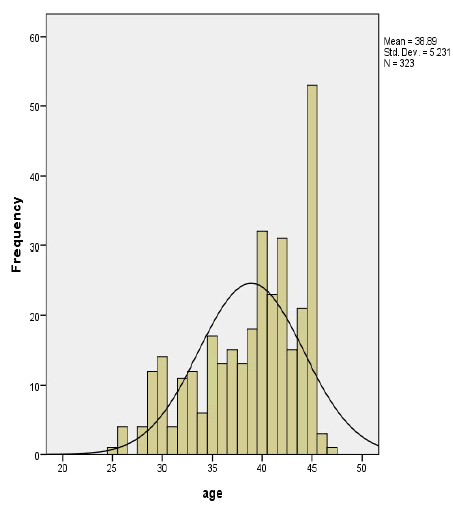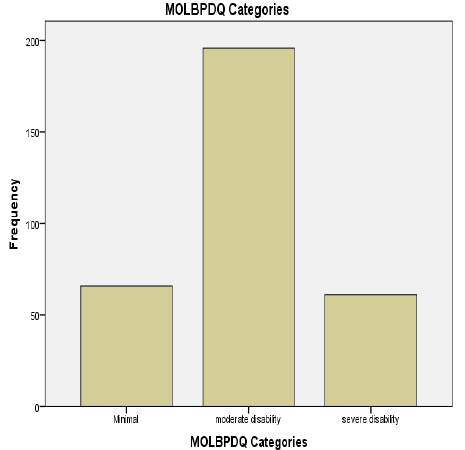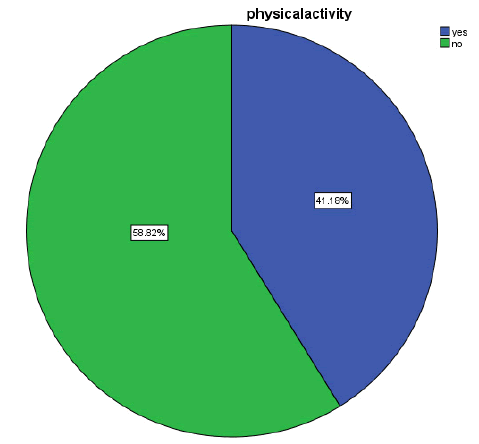Prevalence of Disability Levels of Low Back Pain and Associated Factors among Heavy Vehicle Transport Drivers
1 Department of Physiotherapy, Lecturer at Hajveri Univer sity, Lahore, Pakistan, Email: drzaryyab@hup.edu.pk
2 Department of Physiotherapy, Riphah College of Rehabilitation and Allied Health Sciences, Lahore, Pakistan
3 Department of Physiotherapy, Social Security Teaching Hospital Lahore, Lahore, Pakistan
4 Department of Physiotherapy, Riphah International University, Lahore, Pakistan
5 Department of Medical Science, Tehran University of Medical Sciences, Tehran, Iran
Published: 24-Jun-2022
This open-access article is distributed under the terms of the Creative Commons Attribution Non-Commercial License (CC BY-NC) (http://creativecommons.org/licenses/by-nc/4.0/), which permits reuse, distribution and reproduction of the article, provided that the original work is properly cited and the reuse is restricted to noncommercial purposes. For commercial reuse, contact reprints@pulsus.com
Abstract
Background: Low back pain is defined as pain, muscular tension or stiffness localized below the costal margin and above the inferior gluteal folds, with or without leg pain. Low back pain affects all age groups and is generally associated with sedentary occupations or lifestyle, smoking, obesity and a low economic level. Objective: To determine the prevalence of disability levels of low back pain among heavy vehicle transport drivers. Methodology: A cross sectional survey was conducted through non probability convenient sampling among transport drivers of heavy vehicles. A total of 323 participants, with low back pain participated in the study. Individuals aged between 25 to 47 years with low back pain were included in the study. Data was collected from different transport terminals, hospitals and clinics of Lahore. Pain and disability was measured from modified oswestry low back pain disability questionnaire [1]. Data analysis was done by IBM SPSS Statistics 21. Results: results showed that the minimum age of individuals participated in the study was 25 years and the maximum age was 47 years. It also showed the disability levels among 323 drivers, out of which 66(20.4%) participants had minimal disability and 61(18.9%) of the individuals showed severe disability. However, highest prevalence of disability was seen at moderate level i.e. 196(60.7%) of the individuals. Conclusion: This study concluded a highest prevalence of moderate level of disability in drivers. Also a strong relationship was between low back pain and work years. This concluded that as the years of working of a driver will increase, so is the risk factor of having moderate of severe disability because of increase in low back pain.
Keywords
Low back pain; Modified oswestry low back pain disability questionnaire; Heavy vehicle; Transport driver.
Introduction
Low back pain is characterized as ache, muscle anxiety, or stiffness positioned underneath the costal border and above the inferior gluteal folds [2]. Low back pain is a global situation which influences people of every age and is linked to sedentary occupations, smoking, obesity, and a low socioeconomic repute. The variety of years spent dwelling with low back pain-related incapacity has increased through as much as 50% since 1990, particularly in low-income countries [3]. One of the work-related musculoskeletal diseases is Low Back Pain (LBP). It is seemed as consider one of the important reasons of impairment, activity limitations incapacity to work, and absenteeism from work. Low back pain is the most prevalent kind of work related musculoskeletal disease, causing significant economic costs to both individuals and the society. Professional drivers had been observed to be at a high risk of getting LBP [4]. Back pain in heavy vehicle transport drivers was caused by a variety of factors, including vibrations, strained postures for lengthy durations of time and so on [5]. Professional drivers had been reported to be predisposed to lumbar spine degeneration, intervertebral disc displacement, sciatica, and nonspecific low-back ache. Many factors distinguish drivers from different professions in terms of hazard of work-associated low back problems. The first element is time, as heavy vehicle transport drivers spend more time driving than other jobs. The disparity in space between heavy transport and other vehicles was the second factor. The relatively limited region of transportation might also impose postural stresses at the lumbar spines, placing drivers at chance for LBP and other low back issues. Other issues to consider are air pollution, violence, and psychological stress. Whole-body vibration, lengthy running hours, constrained driving space, road surface shocks, overall miles, time employed as a driver, activity discontent, and place of job strain have all been recognized as primary predictors of low-back soreness amongst drivers. LBP has been related to ergonomic issues along with driver’s seat inclination, seat belts, sitting without lumbar aid, and twisting and bending whilst driving [6].Low back pain affects people of all ages and is one of the top causes of disease worldwide. Because there is no known path anatomical etiology for low back pain, treatment focuses on minimizing pain and its implications. Education and reassurance, analgesic drugs, non-pharmacological therapy, and frequent review are all part of management. Because the clinical history of low back pain is frequently favorable, many individuals require little or no formal medical treatment. LBP is a symptom, not a condition [7]. Low back pain is an everyday fitness problem that impacts 50%–80% of adults at some time of their lives. Adults of working age are nation to be the most persuaded group in relation to LBP, that is main motive of incapacity in the international [8]. CLBP may be as a result of congenital backbone abnormalities. Referred pain to the lower back can be resulting from visceral and pelvic structures. Differential diagnoses of low again ache are structural etiologies of LBP, neurogenic etiologies of LBP and extra spinal etiologies of low back ache [9]. Physical Therapy (PT) has been recommended as a potential treatment for acute LBP, despite debate over its benefits and worldwide standards. The guidelines provide conflicting suggestions for manipulation and exercise treatment [10]. Physical activity, including exercising, has been connected to a reduction in pain and consequently any disability. Passive strategies (rest, drug treatments) have been associated to disability worsening and aren't recommended. Exercise may be used on my own or in combination with different non-pharmacological remedies consisting of yoga, massage, and spinal manipulation. Physical remedy workout is a primary-line remedy for chronic low back ache and need to be done on a normal basis [11]. The different manual therapy procedures, exercises and electrotherapy modalities such as Shortwave Diathermy (SWD), TENS, hot packs and ultrasound etc. are used for low back pain treatment [12].The Modified Oswestry Low Back Pain Disability Questionnaire (MOLBPDQ) is a questionnaire developed to evaluate functional disability in patients suffering with Low Back Pain (LBP). The MOLBPDQ consists of ten items that cover different components of function, including pain intensity, lifting, sitting, standing, walking sleeping, personal hygiene, social life, travelling, and employment/homemaking, which replaces the ODI’s sex life question. Each item is scored from 0to5 where higher values represent greater disability. The total score (ranging from 0 to 5) is multiplied by two and expressed as a percentage [13].
There are very few studies regarding the prevalence of low back pain among heavy vehicle transport. Findings from this research show that there is an association between low back pain and prolong sitting in drivers. Our aim is to determine the prevalence of levels of disability of low back pain among heavy vehicle transport drivers.
Objective
To determine the prevalence of disability levels of low back pain among heavy vehicle transport drivers. It also aims to find associated factors of low back pain in drivers.
Methods
A cross sectional study was conducted among 323 participant that were heavy vehicle transport drivers chosen through non convenient sampling technique. Data was collected between May 2021 to September 2021, from transport terminals, Hijaz hospital, Shalimar hospital and Physioplex clinic situated in Lahore. All the drivers having low back pain for more than a month and aged between 25 to 47 years were included in the study. The drivers who were attending periodic medical examination at health insurance hospital were also included in the study. Whereas, the individuals working at private jobs during off time period either as heavy vehicle transport drivers were excluded from the study. Likewise, all such individuals having any organic diseases such as rheumatoid arthritis, neurological conditions, Psychological disorder and individuals who were not willing, falled into the exclusion criteria. In this particular study, Modified Oswestry Low Back Pain Disability Questionnaire were used as a data collection tool. The questionnaires were then distributed as hand-outs in selected terminals and hospitals. Data was collected in person/ through representatives appointed in selected hospitals and terminals. Data was then entered into IBM SPSS Statistics 21. Pearson correlation test was used for data analysis.
Conclusion
In conclusion tabes dorsalis with long segment extensive transverse myelitis high misdiagnosis was observed. Since all forms of syphilis, especially advanced neurosyphilis are less common than the glory days of syphilis. When encountering long segment hyper intensity spinal cord lesions, we should think of syphilis and undergo related biomarker test and all patient should undergo CSF examination as soon as possible when VDRL is positive in serum. It is important to educate others and to remind ourselves of the multiple faces of the great actor, lues venerea.
It is imperative to be aware of this seemingly rare condition. Early recognition, supportive and intravenous hematin therapy, withdrawal of the precipitating factors are the key steps in the management of acute attacks of AIP. This “little imitator” is often missed or wrongly diagnosed because of its heterogeneous symptoms. This diagnosis requires vigilance as the treatment of seizures with antiepileptic may risk making the patient worse by precipitating the underlying cause.
Results
Figure 1 showed that the minimum age of individuals participated in the study was 25 years and the maximum age was 47 years with mean and standard deviation of age of 38.89 years and 5.231 respectively.
Figure 2 showed the prevalence of increase in low back pain in drivers who were involved in physical loading. Results stated that in 58.82% drivers, any kind of physical activity or weight lifting did not affect the intensity of their low back pain whereas 41.18% drivers reported an increase in their pain intensity with physical loading.
Figure 3 showed the disability levels among 323 drivers, out of which 66(20.4%) participants had minimal disability and 61(18.9%) of the individuals showed severe disability. However, highest prevalence of disability was seen at moderate level i.e.196 (60.7%) of the individuals.
Table 1 showed correlation between daily driving hours and work years with low back pain. A significant relation can be seen between work years and low back pains whereas, a p-value of 0.42 was calculated in case of daily driving hours showing no significant relation between two variables.
| Table 1: Correlation between daily driving hours and work years with low back pain. **. Correlation is significant at the 0.01 level (2-tailed). | |||
|---|---|---|---|
| Pearson correlation | Sig.(2 tailed) | ||
| Daily driving duration | 0.42 | 0.452 | |
| Work years | 0.902** | 0 | |
Discussion
Recent study was conducted to find out the prevalence of low back pain among heavy vehicle transport drivers. In 2013, a study was conducted by ADAMU AHMAD RUFA’I in which two hundred male drivers aged 19–64 years have been recruited within the study. Data regarding prevalence, individual danger factors, and impact of LBP was acquired which was quiet similar to the recent study [14].
Recent study showed that in about half of the individuals, there was an increase in low back pain in drivers who were involved in lifting any weight or any other physical activity. Massimo Bovenzi conducted a study in 2006 on epidemiological study of low back pain in professional drivers. He found out the prevalence of LBP in professional drivers (bus drivers, truck drivers, fork-lift truck drivers etc.) who were exposed to whole body vibration and also weight loading. Massimo confirmed an increase in work-related low back pain in professional drivers. He further stated that important components of intricate origin of low back pain in professional drivers were WBE and physical loading factors which also testifies our hypothesis at certain level [15].
A cross sectional study was conducted by Sally hakim in sep 2017 to find out ergonomic and work related risk factors associated with low-back pain among bus drivers. He chose 180 public bus drivers in his study and found out a significant relationship between increase in work years and low back pain which was quiet similar to our study. He stated that the drivers who were driving the buses for more than 10 years had a higher prevalence of low back pain as compared to the ones with less working years [4].
Conclusion
This study concluded a highest prevalence of moderate level of disability in drivers. Also a strong relationship was between low back pain and work years. This concluded that as the years of working of a driver will increase, so is the risk factor of having moderate of severe disability because of increase in low back pain. An increase in low back pain was also seen in individuals involved in physical loading, however, data was not sufficient enough to prove this hypothesis as other factors such as age, weight, BMI and working hours also contribute to this. So more studies should be conducted as there is insufficient data.
References
- Roland M, Fairbank J. The Roland–Morris disability questionnaire and the Oswestry disability questionnaire. Spine. 2000;25:3115-24.
[Crossref], [Google Scholar], [Indexed]
- Koes B, Van Tulder M, Thomas S. Diagnosis and treatment of low back pain. BMJ. 2006;332:1430-4.
[Crossref], [Google Scholar]
- Clark S, Horton R. Low back pain: A major global challenge. The Lancet. 2018;391:2302.
[Crossref], [Google Scholar], [Indexed]
- Hakim S, Mohsen A. Work-related and ergonomic risk factors associated with low back pain among bus drivers. J Egypt Public Health Assoc. 2017;92:195-201.
[Crossref], [Google Scholar], [Indexed]
- Goon M, Ghoshal S, Chandrasekaran B, Sharma BC. Prevalence of low back pain in long distance truck drivers of mountainous terrain: 1st Edition; 2010.
- AL-Dubai SAR, Qureshi AM, Ismail NH, Rampal KG. Prevalence and determinants of low back pain among taxi drivers in Malaysia. A cross sectional study. Journal of Advanced Medical Research. 2012;2:129-43.
[Crossref], [Google Scholar]
- Maher C, Underwood M, Buchbinder RJTL. Non-specific low back pain. 2017;389:736-47.
[Crossref], [Google Scholar], [Indexed]
- Fatoye F, Gebrye T, Odeyemi IJRi. Real-world incidence and prevalence of low back pain using routinely collected data. Rheumatol Int. 2019;39:619-26.
[Crossref], [Google Scholar], [Indexed]
- Amirdelfan K, McRoberts P, Deer TRJNTatNI. The differential diagnosis of low back pain: A primer on the evolving paradigm. Neuromodulation. 2014;17:11-7.
[Crossref], [Google Scholar], [Indexed]
- Gellhorn AC, Chan L, Martin B, Friedly JJS. Management patterns in acute low back pain: The role of physical therapy. Spine. 2012;37:775.
[Crossref], [Google Scholar], [Indexed]
- Shipton EA. Physical therapy approaches in the treatment of low back pain. Pain Ther. 2018;7:127-37.
[Crossref], [Google Scholar], [Indexed]
- Oppong‐Yeboah B, May S. Management of low back pain in Ghana: A survey of self‐reported practice. Physiother Res Int. 2014;19:222-30.
[Crossref], [Google Scholar], [Indexed]
- Denteneer L, Van Daele U, Truijen S, De Hertogh W, Meirte J, Deckers K, et al. The modified low back pain disability questionnaire: reliability, validity, and responsiveness of a Dutch language version. Spine 2018;43:E292-E8.
[Crossref], [Google Scholar], [Indexed]
- Rufa’i AA, Sa’idu IiA, Ahmad RiY, Elmi OS, Aliyu SU, Jajere AM, et al. Prevalence and risk factors for low back pain among professional drivers in Kano, Nigeria. Arch Environ Occup Health. 2015;70:251-5.
[Crossref], [Google Scholar], [Indexed]
- Bovenzi M, Rui F, Negro C, D’Agostin F, Angotzi G, Bianchi S, et al. An epidemiological study of low back pain in professional drivers. Journal of sound and vibration. 2006;298:514-39.
[Crossref], [Google Scholar]







 The Annals of Medical and Health Sciences Research is a monthly multidisciplinary medical journal.
The Annals of Medical and Health Sciences Research is a monthly multidisciplinary medical journal.